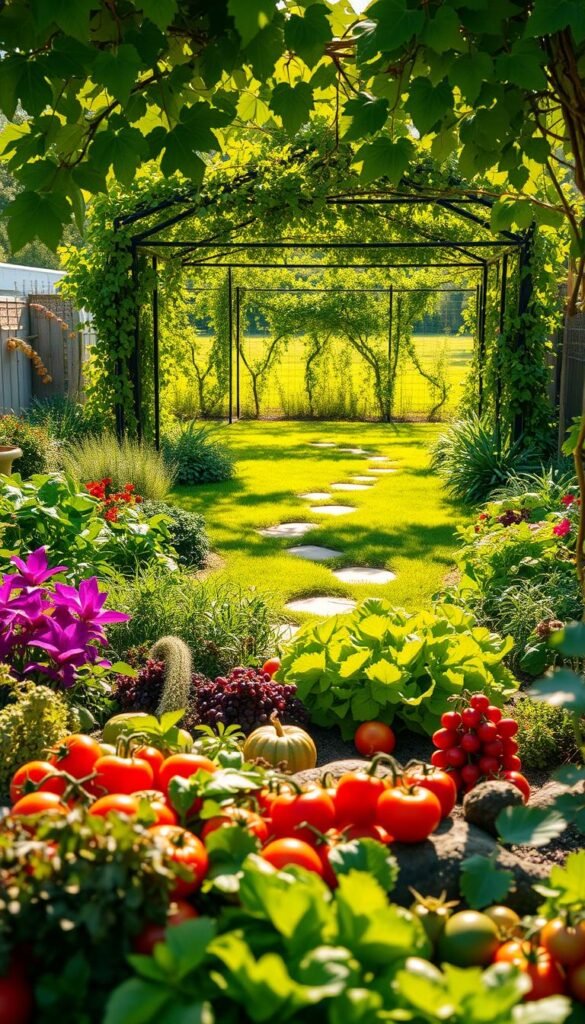Imagine stepping into a garden where juicy strawberries mingle with vibrant kale, and apple trees cast dappled shade over thriving pepper plants. This harmonious blend of fruit and vegetable garden elements isn’t just visually striking—it’s a practical way to maximize your growing space. As horticulturist Steven Biggs notes, “Two gardeners can transform the same plot into entirely different productive landscapes.”
Unified garden layouts do more than save space. They create natural partnerships where plants support each other’s growth. Tall berry bushes can shelter delicate lettuces, while flowering herbs attract pollinators to your tomato vines. You’ll discover how strategic placement boosts yields and reduces pest issues naturally.
The secret lies in viewing your yard as a living tapestry. Instead of separating edibles into rigid zones, consider their colors, textures, and growth habits. A well-planned mix creates visual rhythm while ensuring every square foot works overtime to produce food. Even small spaces can flourish when you layer dwarf fruit trees with vertical vegetable plantings.
This approach transforms ordinary plots into multi-season wonderlands. Picture autumn’s golden squash leaves framing persimmon trees heavy with fruit. With smart design choices, your outdoor area becomes both a pantry and a retreat—proving beauty and productivity grow best when rooted together.
Introduction to a Cohesive Garden Vision
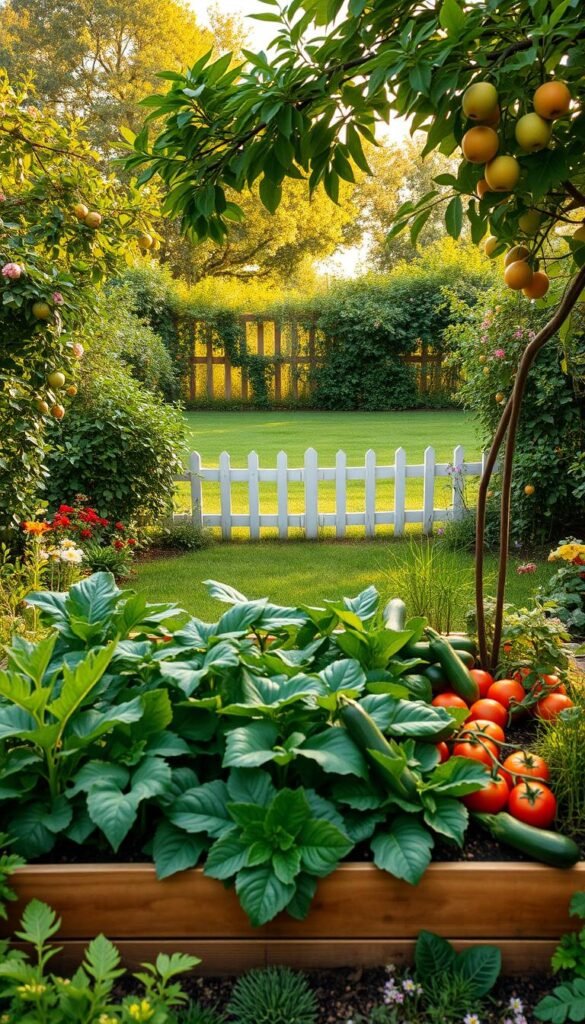
See your outdoor space reimagined as a productive paradise where every plant serves multiple purposes. The magic begins when you design with harmony as your guide—letting colors, heights, and textures flow like brushstrokes on nature’s canvas.
Why Blended Gardens Work Better
Mixing fruits and vegetables creates a living network of benefits. Diverse plantings attract ladybugs and lacewings that devour aphids, while taller crops like pole beans provide shade for heat-sensitive greens. You’ll spend less time battling pests and more time harvesting.
Smart layouts maximize every inch. Instead of separate plots for berries and tomatoes, interplant them in shared beds. This approach reduces wasted space between rows and creates microclimates that help plants thrive. A study by Urban Harvest found mixed gardens yield 23% more food per square foot than traditional setups.
Defining Your Garden’s Purpose
Start by asking: What matters most to your household? Love fresh salads? Prioritize leafy greens and strawberries. Short on time? Focus on low-maintenance crops like zucchini and dwarf fruit trees. Consider these factors:
- Sun patterns across your lot
- Soil type and drainage
- Weekly time available for gardening tasks
By matching plants to your lifestyle and conditions, you’ll create a space that’s both beautiful and bountiful. Remember—successful gardens grow from realistic plans, not Pinterest-perfect fantasies.
Planning Your Garden Layout
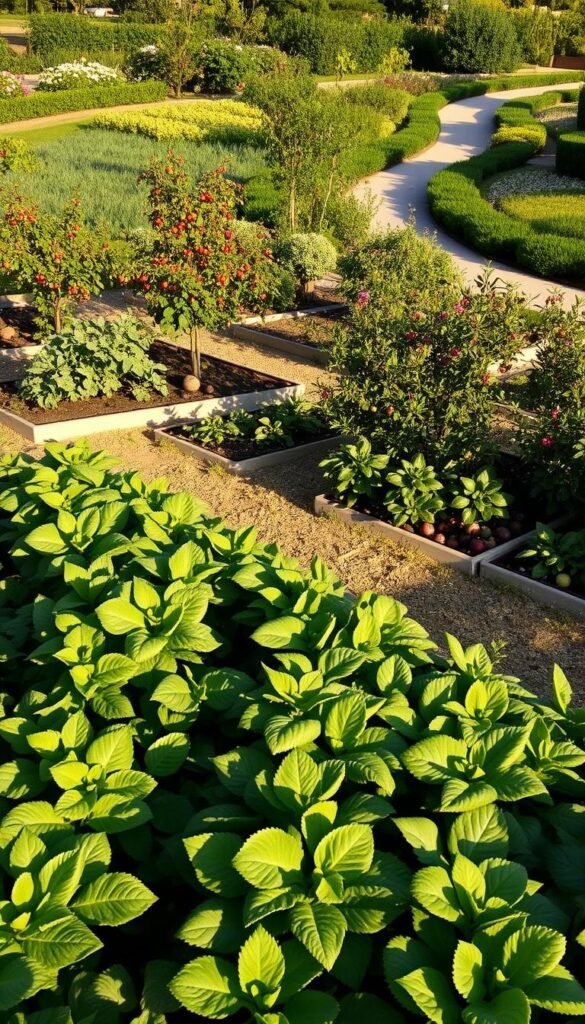
Transform your outdoor space into a living mosaic where every plant plays its part. The right layout balances beauty and function, letting you grow more while keeping maintenance manageable. Let’s explore how strategic arrangements can turn even awkward corners into productive zones.
Design Principles for Unified Growth
Pam Frost’s big brother/little brother method creates instant harmony. Pair a showstopper like a fig tree with smaller companions sharing leaf shapes or colors—maybe purple basil or silver thyme. This creates rhythm without rigid patterns.
Curved beds work magic in tight spaces. Gentle arcs add 15% more planting room than straight lines while softening hard edges. Place taller plants at the curve’s peak for natural focal points. Leave 3-4 feet between sibling pairs to let each grouping shine.
Smart Space Mapping Strategies
Before digging, sketch your garden beds with these elements:
| Element | Traditional Layout | Blended Design |
|---|---|---|
| Plant Pairings | 10% matched | 30% siblings |
| Harvest Access | Straight paths | Winding trails |
| Visual Flow | Block sections | Layered heights |
Mark main walkways first—18 inches wide for easy harvesting. Use temporary stakes to test paths. Remember: leave space for kneeling and tool storage. A well-planned design lets you reach every plant without trampling tender greens.
Mix repetition and surprise. Repeat your favorite duos in different zones, but vary supporting plants. This 30/70 ratio keeps the eye moving while grounding the space. Your garden becomes a journey of discovery, where each turn reveals new textures and flavors.
Maximizing Garden Beds and Space
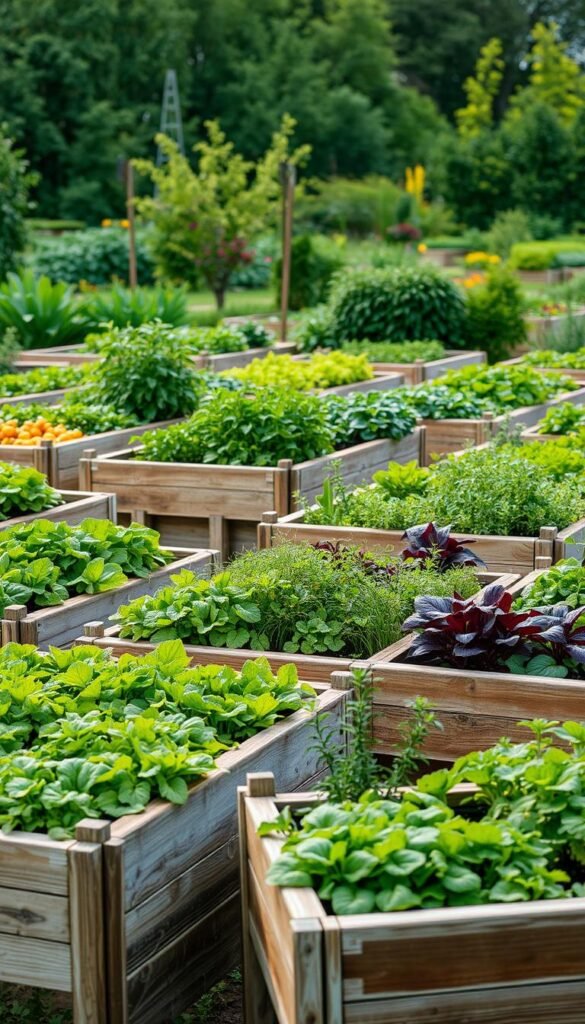
Turn every inch of your growing area into a powerhouse of productivity. Smart bed choices can double your harvest while cutting maintenance time. Horticulturist Steven Biggs puts it simply: “Block planting beats rows when space matters—more plants, less dirt.”
Choosing the Right Garden Beds and Raised Systems
Block planting packs plants tightly like puzzle pieces. Unlike traditional rows with empty aisles, this method uses 40% more garden space effectively. You’ll fit 12 tomato plants where rows only allow 8, with leafy greens filling gaps between stems.
Raised beds solve multiple challenges at once. Their elevated design warms soil faster for early crops and keeps roots from drowning in heavy rains. A 12-inch height works for most veggies, but dwarf fruit trees thrive in deeper 18-inch boxes.
- 4-foot widths let you reach center plants without compacting soil
- Pathways between beds should be 18-24 inches for easy kneeling
- Use cedar or composite boards for lasting durability
Match bed depth to plant needs. Shallow 8-inch setups suit lettuces and herbs, while berry bushes demand 14+ inches for root spread. Pairing different heights creates visual interest—stack a tall strawberry tower beside low-profile spinach beds.
How to Combine Fruit and Vegetable Gardens in One Cohesive Design
Smart pairings transform ordinary plots into edible masterpieces. Steven Biggs advises: “Grow what excites your taste buds, not what drains your space.” Skip slow-growing vegetables like Brussels sprouts that monopolize beds for months. Instead, focus on crops delivering continuous harvests.
Integrating Different Plant Types Effectively
Dwarf fruit trees become living trellises for climbing beans. Position taller plants like apples or pears at beds’ north end. Mid-height berries fill central zones, while compact vegetables like radishes claim southern spots for full sun.
Match soil preferences to simplify care. Blueberries thrive alongside potatoes—both love acidic earth. Time plantings so strawberries peak as tomatoes start flowering. This staggered approach keeps your kitchen stocked without glut.
Designate permanent areas for raspberry canes and asparagus crowns. Surround them with rotating annuals like spinach or bush beans. You’ll enjoy fresh picks from spring frosts through autumn’s first chill while keeping beds productive year-round.
Managing Soil, Sunlight, and Water
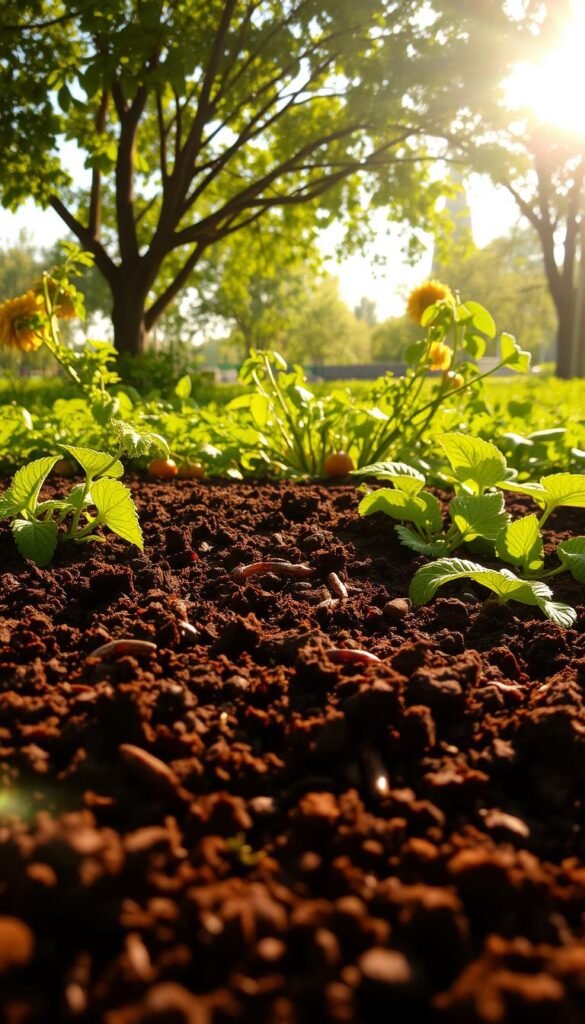
Your garden thrives when its core elements work in concert. Balancing earth, light, and moisture creates ideal conditions for diverse crops. Let’s explore how to align these factors for year-round abundance.
Preparing Soil for Mixed Plantings
Start by zoning your beds based on root depth. Fruit trees need 18+ inches of well-draining soil, while lettuces flourish in 6-inch rich topsoil. Layer compost to boost drainage for berries and moisture retention for spinach in adjacent areas.
Steven Biggs recommends separate blocks for perennial vegetables like asparagus. These long-term growers benefit from undisturbed soil enriched with aged manure. Annuals thrive in rotating zones where you can refresh nutrients each season.
Optimizing Sun and Shade for Healthy Growth
Map sunlight patterns monthly—tomatoes crave 8 hours of direct sun, while mint prefers dappled afternoon shade. Use taller plants as natural sun filters. A pear tree’s canopy creates perfect cool spots for leafy greens.
Drip irrigation simplifies watering needs. Set zones for thirsty veggies like cucumbers and low-water fruits like figs. Mulch with straw around strawberries to retain moisture without drowning their shallow roots.
Utilizing Vertical Space for Extra Planting Area
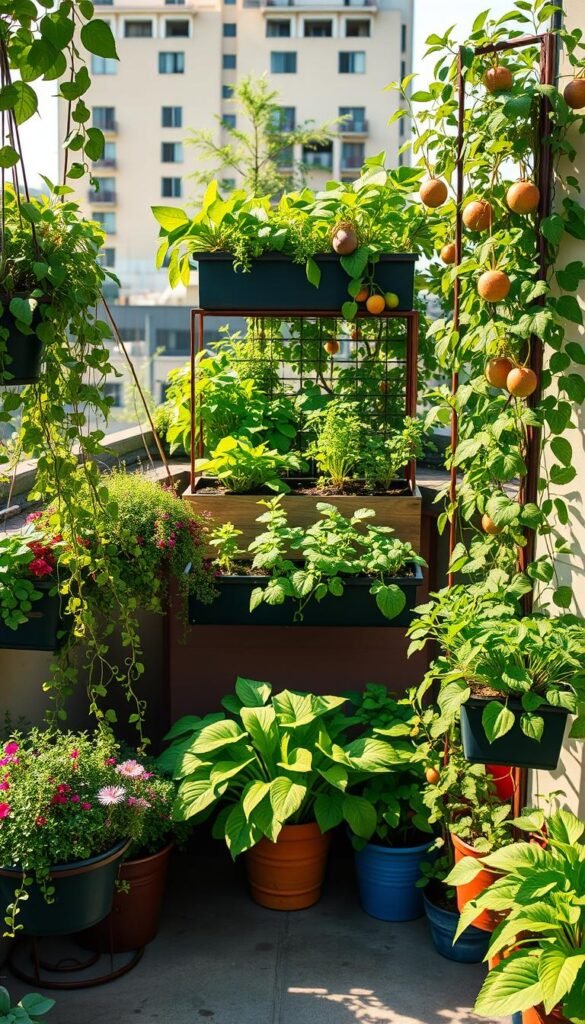
Your garden’s third dimension holds untapped potential. Vertical growing lets you harvest pounds of produce without sacrificing precious ground space. Horticulturist Steven Biggs emphasizes: “Think upward first—every foot of airspace above your beds is free real estate.”
Vertical Gardening Techniques for Fruits and Vegetables
Train climbers like pole beans on bamboo tripods. Their twining stems create living walls that shelter shade-loving greens below. Try these space-saving pairs:
| Vertical Crop | Ground Partner | Yield Boost |
|---|---|---|
| Cucumbers | Spinach | +40% |
| Malabar Spinach | Lettuce | +35% |
| Achocha | Basil | +28% |
Build A-frames from cattle panels for heavy vines. These arched supports handle 15-pound squash while creating cool microclimates underneath. Leave 3 feet between structures for easy harvesting.
Choosing Trellises and Supports
Match materials to plant weight. Wire mesh works for peas, but melons need sturdy cedar posts. Consider these options:
- Espaliered apple trees along fences
- Hanging strawberry planters on shed walls
- T-posts with nylon netting for beans
Space vertical crops 12-18 inches apart for air flow. Rotate climbing plants yearly to prevent soil diseases. With smart upward planning, you’ll triple yields while keeping your garden walkways clear and accessible.
Embracing Companion Planting Strategies
Unlock nature’s teamwork by pairing plants that help each other thrive. This ancient practice solves modern gardening challenges while creating eye-catching combinations. Steven Biggs’ radish-carrot duo shows how strategic pairings boost yields and simplify maintenance.
Big Brother/Little Brother Plant Pairings
Try Biggs’ favorite trick: scatter radish and carrot seeds together. The radishes sprout fast, marking rows while loosening soil. When you harvest them weeks later, carrot seedlings get instant breathing room. This gardening hack eliminates thinning chores naturally.
Tall raspberry canes make perfect “big brothers” for golden fuchsia. Their matching chartreuse leaves create visual harmony while attracting pollinators. The berries’ height shelters smaller plants from harsh sun without competing for root space.
Benefits of Complementary Crop Choices
Beans and tomatoes form power partnerships. Legumes add nitrogen to soil that heavy feeders crave. Plant bush beans around corn stalks—their shallow roots won’t battle for nutrients. You’ll get three crops from one bed: sweet corn, snap beans, and juicy tomatoes.
Time your plantings like a pro. Sow quick-growing lettuce between slow-maturing cabbage. By harvest time, the leafy greens have shaded tender brassica seedlings. This staggered approach keeps your vegetable garden productive through multiple seasons.
Layering and Curving for a Dynamic Garden Design
Curved garden beds do more than save space—they create optical magic. Pam Frost transformed her narrow lot by swinging bed lines like graceful brushstrokes. Her secret? A garden hose became the ultimate design tool for shaping flowing borders that trick the eye into seeing expansiveness.
Creating Depth with Curved Beds
Gentle arcs add 15% more planting space than rigid lines while softening harsh angles. Position taller fruit trees at curves’ peaks—their height becomes natural focal points. Mid-layer berries and tomatoes fill the slopes, with herbs hugging the front edges like living trim.
Use Frost’s hose technique: outline temporary borders, then expand them over years as your confidence grows. This gradual way of working lets your garden evolve organically, blending textures and flavors without overwhelm.
Curved paths invite exploration, making visitors wonder what’s around each bend. Pair this sense of discovery with smart layering—deep purple kale beneath pear trees, scarlet strawberries edging bean towers. Your design becomes a living journey where every turn delights both eyes and appetite.

